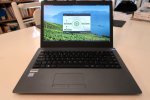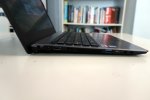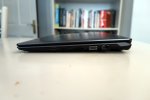Detailed spec and pictures below; here is a slightly expanded report on my new Ultranote originally posted in the Linux forum, which I bought as a lightweight carry anywhere machine on which to install Linux. Quality is comparable with any machine in the same price band, and it's a good looking piece of kit, thinner and lighter than current IdeaPad. The trackpad works well, and the keys have a good amount of travel, although the space key needs to be hit pretty much in the centre to register, something picked up by other reviews. The only intensive work I do is moderate photo editing, using Gimp, which is why I opted for the full HD screen, which is excellent once you get used to the size. No dead or stuck pixels!
Battery life is about average as far as I can tell - around four hours - but I haven't really had the opportunity to test it fully. The only slightly odd thing is the way the bottom of the lid acts as the 'rear legs' of the computer on a flat surface, lifting the battery compartment clear of the surface. This is obviously intentional as there are small pads on the back edge of the screen to take the weight. But the hinges look solid enough.
Now to Linux: a flawless install in less than 15'! I've been an XFCE user for quite a while, and before that Gnome 2, but was sufficiently taken by the new Plasma desktop that I decided with the extra power to give Kubuntu 18.04 a try. I plugged in my USB, hit F7 for the boot menu and took it from there, keeping the existing EFI partition and deleting everything else to set up root and home. Curiously this left an entry for Windows in GRUB although I had deleted it, but after a few days I decided in any case I couldn't really adjust to KDE and did a fresh install of Ubuntu Mate, letting the installer handle everything, which fixed the problem. (I had ordered it without operating system, but a version of Windows remains on the system from the testing process.) With both distros everything worked out of the box except F1 to disable the touch pad and F11 for flight mode, though Ubuntu Mate seemed to adjust itself to the HD screen without as much tweaking as Kubuntu. The card reader recognised my SDHC card without problem.
PC Specialist kept me informed throughout. I ordered on 4 June and had it 9 days later. The only slight glitch was the delivery instructions: PCS tell you not to sign for receipt until you've opened the box and checked; the DPD driver told me once I'd opened it he couldn't take it back, and all I could do was check the box. In the event all was fine! If I had had the budget, no doubt the 13" Lafite would have been nice, and the faster PCIe M2 memory; but for the price and my purposes, I'm more than happy.
--
Chassis & Display
UltraNote Series: 14" Matte Full HD 60 Hz 45% NTSC LED Widescreen (1920x1080)
Processor (CPU)
Intel ® Core™ i5 Quad Core Processor i5-8250U (1.60GHz, 3.4GHz Turbo)
Memory (RAM)
8GB Corsair 2133MHz SODIMM DDR4 (1 x 8GB)
Graphics Card
INTEL® HD GRAPHICS 610/620/630 (CPU Dependant) - 1.7GB Max DDR4 Video RAM - DirectX ® 12
1st Hard Disk
240GB ADATA SU650 2.5" SSD, SATA 6 Gb (520MB/R, 450MB/W)
Memory Card Reader
Integrated 6 in 1 Card Reader (SD /Mini SD/ SDHC / SDXC / MMC / RSMMC)
Audio
Realtek 2 Channel High Definition Audio + MIC/Headphone Jack
Bluetooth & Wireless
GIGABIT LAN & WIRELESS INTEL ® AC-9260 M.2 (1.73Gbps, 802.11AC) +BT 5.0
USB Options
1 x USB 3.1 PORT (Type C) + 1 x USB 3.0 PORT + 1 x USB 2.0 PORT



Battery life is about average as far as I can tell - around four hours - but I haven't really had the opportunity to test it fully. The only slightly odd thing is the way the bottom of the lid acts as the 'rear legs' of the computer on a flat surface, lifting the battery compartment clear of the surface. This is obviously intentional as there are small pads on the back edge of the screen to take the weight. But the hinges look solid enough.
Now to Linux: a flawless install in less than 15'! I've been an XFCE user for quite a while, and before that Gnome 2, but was sufficiently taken by the new Plasma desktop that I decided with the extra power to give Kubuntu 18.04 a try. I plugged in my USB, hit F7 for the boot menu and took it from there, keeping the existing EFI partition and deleting everything else to set up root and home. Curiously this left an entry for Windows in GRUB although I had deleted it, but after a few days I decided in any case I couldn't really adjust to KDE and did a fresh install of Ubuntu Mate, letting the installer handle everything, which fixed the problem. (I had ordered it without operating system, but a version of Windows remains on the system from the testing process.) With both distros everything worked out of the box except F1 to disable the touch pad and F11 for flight mode, though Ubuntu Mate seemed to adjust itself to the HD screen without as much tweaking as Kubuntu. The card reader recognised my SDHC card without problem.
PC Specialist kept me informed throughout. I ordered on 4 June and had it 9 days later. The only slight glitch was the delivery instructions: PCS tell you not to sign for receipt until you've opened the box and checked; the DPD driver told me once I'd opened it he couldn't take it back, and all I could do was check the box. In the event all was fine! If I had had the budget, no doubt the 13" Lafite would have been nice, and the faster PCIe M2 memory; but for the price and my purposes, I'm more than happy.
--
Chassis & Display
UltraNote Series: 14" Matte Full HD 60 Hz 45% NTSC LED Widescreen (1920x1080)
Processor (CPU)
Intel ® Core™ i5 Quad Core Processor i5-8250U (1.60GHz, 3.4GHz Turbo)
Memory (RAM)
8GB Corsair 2133MHz SODIMM DDR4 (1 x 8GB)
Graphics Card
INTEL® HD GRAPHICS 610/620/630 (CPU Dependant) - 1.7GB Max DDR4 Video RAM - DirectX ® 12
1st Hard Disk
240GB ADATA SU650 2.5" SSD, SATA 6 Gb (520MB/R, 450MB/W)
Memory Card Reader
Integrated 6 in 1 Card Reader (SD /Mini SD/ SDHC / SDXC / MMC / RSMMC)
Audio
Realtek 2 Channel High Definition Audio + MIC/Headphone Jack
Bluetooth & Wireless
GIGABIT LAN & WIRELESS INTEL ® AC-9260 M.2 (1.73Gbps, 802.11AC) +BT 5.0
USB Options
1 x USB 3.1 PORT (Type C) + 1 x USB 3.0 PORT + 1 x USB 2.0 PORT



Last edited:
